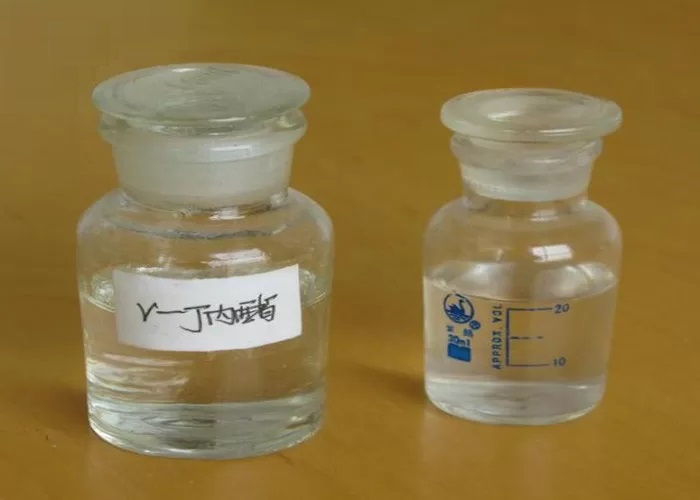We unleash your business potential by maximize the business innovation.
Send EmailGAMMA BUTYROLACTONE, Gamma-Butyrolactone, Butyrolacton, Oxolanone, γ-butyrolactone, Gamma Butyrolactone, n-Butyronitrile, Dihydrofuran-2-one, 4-Hydroxybutyric Acid Lactone, GBL, BLO, 96-48-0
gamma-butyrolactone
CAS: 96-48-0
🌟 Gamma-Butyrolactone (GBL)
A) Physical and Chemical Properties
-
Chemical Formula: C₄H₆O₂
-
Molecular Weight: 86.09 g/mol
-
Appearance: Clear, colorless liquid
-
Odor: Mild ester-like smell
-
Melting Point: −44 to −45 °C
-
Boiling Point: ~204–205 °C
-
Density: ~1.12–1.13 g/cm³ (25 °C)
-
Solubility: Fully miscible with water and most organic solvents
-
pH (100 g/L in water): 4–5
-
Flash Point: ~98–101 °C (closed cup)
-
Explosion Limits: ~16% (v/v)
-
Refractive Index: n₂₀/D 1.436
-
Vapor Pressure: ~0.34 hPa @ 20 °C
-
Autoignition Temperature: ~455 °C
-
WGK (Germany): 1 (low water hazard)
-
EC No: 202-509-5
B) Applications
-
Solvent: For photosensitive resins, special inks, and lithium battery electrolytes
-
Intermediate: In the synthesis of 2-Pyrrolidone, NMP, NVP, and PVP
-
Pharmaceuticals: Precursor to GHB (regulated use)
-
Electronics: Used in capacitor and battery formulations
-
Casting Binder & Coatings: As a dispersing and binding agent
C) Manufacturing Method
-
Main Route: Hydrogenation of maleic anhydride or succinic acid
-
Catalyst: Palladium or copper-based systems
-
Process Type: Continuous production (e.g., Mitsubishi Chemical)
-
Purity: ≥99.5% (technical or synthesis grade)
D) Chemical Reactions
-
Lactone Ring Opening: Under acidic or basic conditions
-
Conversion to Pyrrolidones: Via reaction with ammonia or amines
-
Polymerization: As a monomer or co-monomer in specialty polymers
E) Alternatives
-
2-Pyrrolidone: More reactive, used in polymer synthesis
-
N-Methyl-2-pyrrolidone (NMP): Higher boiling point solvent
-
Propylene Carbonate: Safer aprotic solvent
-
Ethyl Lactate: Bio-based alternative with similar solvency
F) Synonyms Gamma-Butyrolactone, GBL, Dihydrofuran-2-one, 4-Hydroxybutyric acid lactone
G) Common Names “GBL solvent” “Battery-grade lactone” “PVP precursor”
H) Usage Ratios
-
Pyrrolidone synthesis: Stoichiometric conversion
-
Battery electrolytes: ~5–20% in solvent blend
-
Coatings & resins: ~2–10% depending on formulation
Molecular Formula: C4H6O2
Names and Identifiers
| Name | gamma-butyrolactone |
| Synonyms | GBL BLO 2-Oxolanone γ-butyrolactone γ-Butyroalctone n-Butyronitrile γ-Butyrrolactone 1,4-Butyrolactone Gamma-Butyroalctone Gamma ButyroLactone gamma-butyrolactone 2-Oxotetrahydrofuran 2(3H)-dihydrofuranone 1-Oxacyclopentan-2-one 2(3H)-furanone,dihydro- 4,5-Dihydro-2(3H)-furanone 2,3-dihydroxybutanoic acid 3-Hydroxybutyric acid lactone 2,3,4,5-tetrahydro-2-furanone 4-Hydroxybutyric acid lactone 4-Hydroxybutyric acid gamma-lactone |
| CAS | 96-48-0 |
| EINECS | 202-509-5 |
| InChI | InChI=1/C4H8O4/c1-2(5)3(6)4(7)8/h2-3,5-6H,1H3,(H,7,8) |
Physico-chemical Properties
| Molecular Formula | C4H6O2 |
| Molar Mass | 120.104 |
| Density | 1.413g/cm3 |
| Melting Point | -45℃ |
| Boling Point | 358.8°C at 760 mmHg |
| Flash Point | 185°C |
| Water Solubility | MISCIBLE |
| Vapor Presure | 1.36E-06mmHg at 25°C |
| Refractive Index | 1.503 |
| Physical and Chemical Properties | Character: colorless transparent liquid. boiling point 35 ℃ freezing point relative density 1.129 refractive index 1.4348 flash point 98 ℃ solubility is miscible with water and common organic solvents. Slightly soluble in aliphatic hydrocarbons. |
| Use | For the production of cyclopropylamine, pyrrolidone and other drugs, but also industrial solvents, diluents, curing agents |
Risk and Safety
| Hazard Symbols | Xn - Harmful |
| Risk Codes | R22 - Harmful if swallowed R36 - Irritating to the eyes |
| Safety Description | S26 - In case of contact with eyes, rinse immediately with plenty of water and seek medical advice. S39 - Wear eye / face protection. |
Nature
A colorless and transparent oily liquid with a certain hygroscopicity and a slight odor. Miscible with water, alcohols, esters, ethers, ketones and aromatic hydrocarbons, sparingly soluble in linear and cycloalkanes. Freezing point -43. 53 ℃, boiling point 206 ℃(101. 3kPa) relative density 1. 129, refractive index 1. 4362, Flash Point (Open Cup) 98 ℃, ignition point 455 ℃.
Preparation Method
- 1,4-butanedione dehydrogenation method in the presence of a catalyst, 1,4-butanediol first dehydrogenated to generate 7L hydroxybutyraldehyde, and then condensed and dehydrogenated to generate γ-butyrolactone.
- direct hydrogenation of maleic anhydride
Use
mainly used for the synthesis of pyrrolidone, chlorophenoxybutyrate herbicides, plant growth regulators. It can also be used as a polymer solvent, an extractant for petroleum processing, etc.
Safety
- This product is a low toxic substance, which has anesthetic effect on the central nervous system. The oral LD50 = 1800mg/kg in rats has a stimulating effect on the skin, mucosa and upper respiratory tract irritation.
- can be stored and transported in ordinary steel containers, can not be stored and transported in rubber, phenolic resin, epoxy resin, concrete and sharp equipment, and slightly yellowing in color in long-term storage in steel containers. Storage and transportation should be away from the fire, heat source, to prevent direct sunlight, keep the container sealed. Storage in a dry, cool, ventilated space, and with oxidants, acids, alkalis separated.
